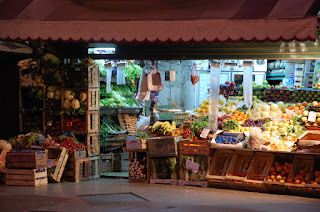
In late July we headed off for a wonderful 6-week excursion of Europe via train, from the Baltic Sea in the north to the Adriatic and Mediterranean in the south to the Atlantic Ocean in the west. (It's taken almost as long for Linda to sort through the photos, figure out Picassa, and upload the best of the tour!) Following are our itinerary, some notes on the trip, and a visual summary.
Sight-seeing in Stockholm, where Linda's sister Judy, brother-in-law Claes, and nephew Edward live, boat excursion through the archipelago, trip to the country house in Ekeby. Plus, we get a chance to visit with Swedish friends Peter and Dragana, who returned to Stockholm from Austin earlier in the year. Other highlights of the visit: great meals, compliments of Chef Claes; mushroom hunting in Ekeby with supersleuth Judy; and the grand show at Europe Pride 2008, organized and directed by Edward.
From Stockholm we train south in the first leg of our Eurail adventure. On the suggestion of our friendly reservation agent in Sweden, we've built in a 7-hour layover in Copenhagen that allows us to explore a small part of Denmark's capital.
From there, we take the night train to Munich, Germany, sharing a sleeping compartment of 6 "couchettes" with an Italian set designer and her Swedish daughter and a Palestinian man. Lots of talk about food from around the world and about politics. Universal thumbs down for Bush.
A quick connection in Munich in the morning, and less than 6 hours later we're in Verona, Italy, where another 7-hour layover gives us the opportunity to check out the ancient town that served as a setting for several Shakespearian plays. We see the house of Juliet and find our way back through the maze of narrow medieval streets to the train station. From there, we catch the night train -- this time with our own private sleeping compartment -- to Brindisi, in the very southern tip of Italy.
We stay practically on the Mediterranean in Campomarino with the Mazzas (mother Adriana, Grandmother Nona, and sons Nico, Roberto, and Gianluca), second family for our daughter
Belen. She and son Joey join us for 2 weeks of sunshine, swimming, cheap wine and fantastic food, and good times with the Mazzas and their aunts, uncles, and cousins. We visit Oria, where Frederick the Great built a fortress during the Crusades; Manduria, where convenient pump tanks offer your choice of Primitivo or Negro Amaro; and Marrugio, for pizza and open-air Tarantella concert.
Starting on the final leg of our trip, we're put on the train in Brindisi by Gianluca and Belen and then met at Rome's Termini station by Roberto. A great conclusion to the Italian tour, capped off by the private sleeper to Bern, Switzerland. There, a short 2-hour layover in the early morning is just enough time to get a feel for this city. Then we're off on the high-speed train to Paris, ooh-ing and aah-ing at the countryside and towns.
August 28-September 4:
ParisWe stay at a comfy apartment in the 3rd Arrondissement, within walking distance of the Louvre, Notre Dame, Musee d'Orsay, and hundreds of eating establishments. We take a boat tour on the Seine and a one-day excursion by train to
St. Malo on the Normandy coast (definitely a place to come back to.)
What a great trip!
 This entry was supposed to have been the recap of our family's Christmas vacation in San Martin de los Andes. That is being postponed; warm and fuzzy feelings of holiday celebrations seem trivial in the face of the massacres in the Gaza Strip. (Photo from Aljazeera.net through The Palestinian Chronicle.)
This entry was supposed to have been the recap of our family's Christmas vacation in San Martin de los Andes. That is being postponed; warm and fuzzy feelings of holiday celebrations seem trivial in the face of the massacres in the Gaza Strip. (Photo from Aljazeera.net through The Palestinian Chronicle.)




























 part of the greater Recoleta neighborhood.
part of the greater Recoleta neighborhood.